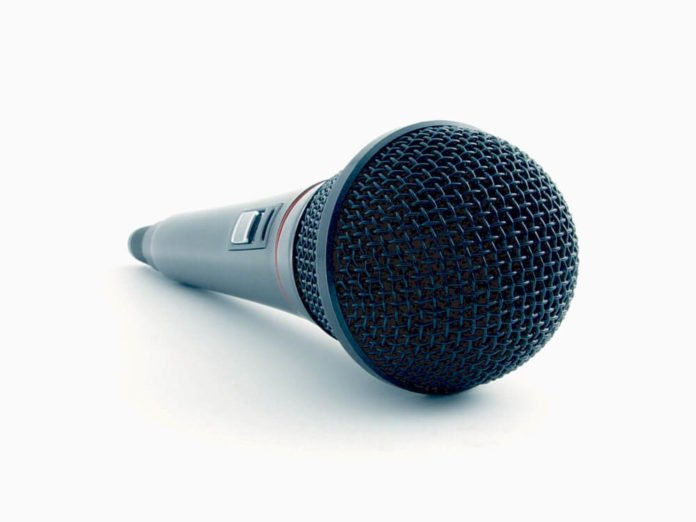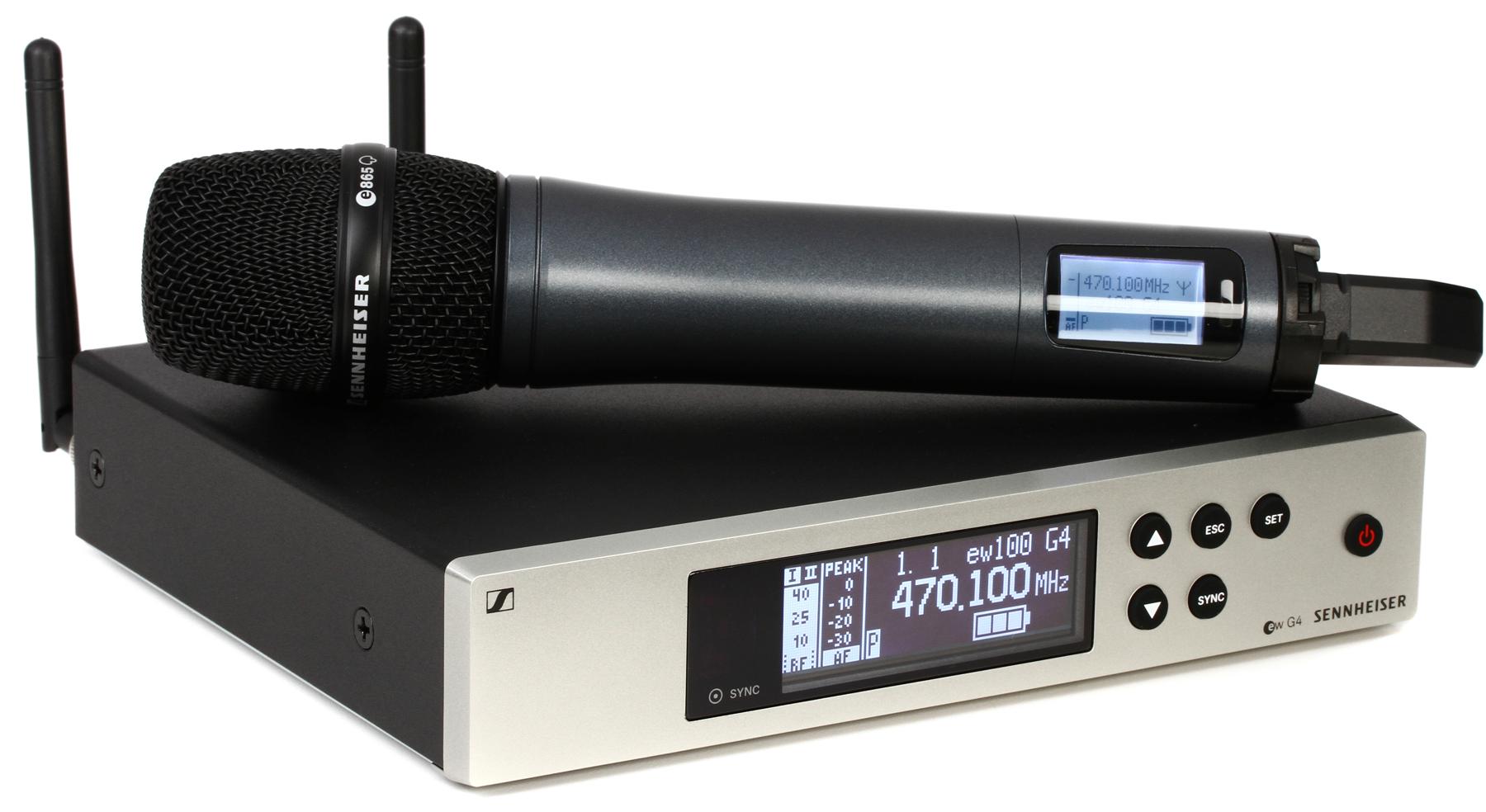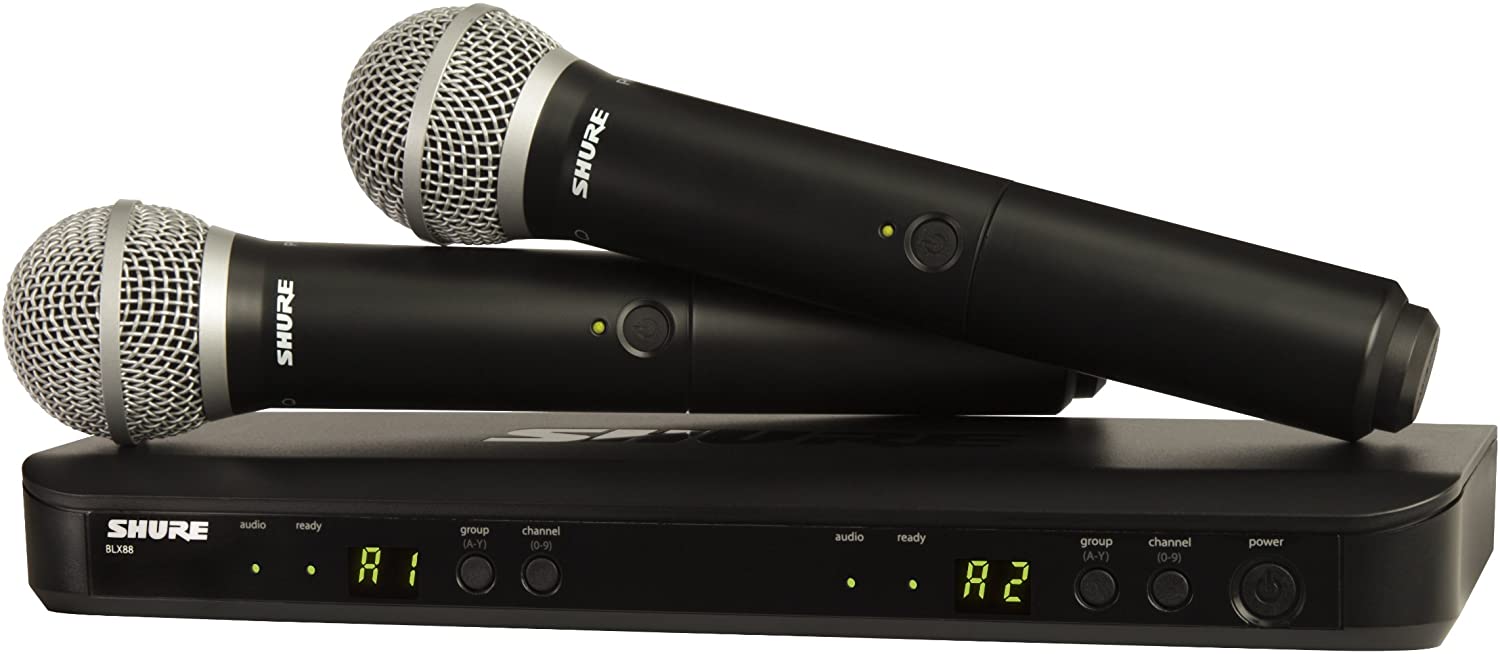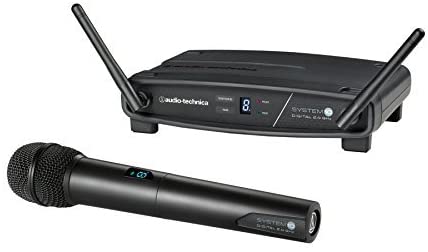Wireless mics’ convenience and flexibility make them excellent sound input tools in the home, professional studio, entertainment venues, and other places.
While wireless microphones cannot match the sound quality of wired systems, one can always pick high-quality audio input devices to produce the best sound possible.
As a musician and sound producer, I want to share my professional opinion on what the best wireless microphone is on the market today.
Of the ten mics I tested and reviewed, the Shure BLX288/PG58 came out on top.
This dual-channel with intelligent frequency selection is the perfect microphone for vocalists, recording artists, aspiring musicians, and anyone who wants exceptional sound quality from their mics.
I know that people may disagree with my choice.
That is why I included a review of the other nine wireless microphones, which are the best in their respective categories.
Let us begin.
Contents
The Best Wireless Microphones
- Shure BLX288/PG58 – Best Wireless Microphone Overall
- Sennheiser EW 100 G4-835-S – Best Premium Wireless Microphone
- Audio-Technica ATW-1102 – Best Value Digital Wireless Microphone
- Shure PGXD24/SM58-X8 – Best Handheld Wireless Microphone
- Shure SLX2/SM58 – Best Wireless Microphone with for Speech Applications
- Sony DWZ-M70 – Best Customizable Wireless Microphone
- Behringer ULM300USB – Best Wireless Microphone for Globe-trotters
- Rode Wireless GO Compact – Best Wireless Microphone for Content Creators
- Sennheiser XSW 2-835 – Best Gig-ready Digital Wireless Microphone
- Boss WL-30XLR – Best Plug-and-Play Wireless Microphone System
Also Great | Editor's Choice | Budget Pick |
Shure BLX288/PG58
The Shure BLX288/PG8 is an advanced analog wireless microphone suitable for aspiring lead vocalists and backup singers.
The package comes with a pair of legendary PGA58 dynamic microphones that feature exceptional sound quality production optimized for speech and vocals.
Not only are the mics stunning, but they are also ridiculously versatile, allowing anyone to use them as lavalier, headset, and guitar inputs.
Selecting the correct frequency is effortless with the mic’s advanced one-touch QuickScan technology, ensuring singers and sound producers get the best possible open frequency for their projects.
Each frequency band can also accommodate a maximum of a dozen compatible systems, making the wireless microphones a venerable workhorse.
Where other mics can only accommodate radio frequencies up to several tens of feet, this microphone delivers exceptional sound up to 300 feet from the powerful base station.
It is not surprising why many pros consider it the best wireless microphone today.
Pros
- Versatile output options
- Two legendary microphones
- Intelligent frequency scanning and selection
- Extended wireless range
Cons
- Tends to pick up more noise than digital systems
Sennheiser EW 100 G4-835-S
If you are ready to spend on a professional-grade wireless microphone, the Sennheiser EW 100 G4=835-S is the one to get.
There are hundreds of reasons why this wireless microphone has a premium price tag.
Built inside a rugged aluminum housing are a revolutionary HDX compander and advanced algorithm that delivers exceptionally crystal-clear sounds.
This mic delivers superior SPL handling, unparalleled feedback rejection, and a warm and smooth sound people will think they are inside a big-name recording studio.
The wireless microphone offers effortless frequency switching, noise muting, enhanced AF range, and intelligent infrared transmitter synchronization.
Fine-tuning the sound quality is hassle-free with the controller’s high-contrast LCD, dedicated Escape button, blue sync LED, and user-friendly menus.
Vocalists and sound producers will also love its Soundcheck mode, integrated equalizer, and interchangeable Evolution-series mic modules.
Pros
- Lightweight yet rugged and powerful transmitter
- Professional-quality sound
- Feature-rich wireless microphone
- Unparalleled sound control
Cons
- Shorter battery runtime than others
Audio-Technica ATW-1102
Offering unique IDs and pain-free channel selection at a price many people will find a steal, the Audio-Technical ATW-1102 continues to win sound producers and vocalists to its fold.
Each transmitter and receiver displays a unique identity, allowing users to make effortless fine-tuning of the system where it matters the most.
Thanks to its advanced 24-bit operation and balanced XLR technology, this microphone delivers dependable and rock-solid performance.
While it only has two receiver sections, its algorithm ensures true space and time diversity to reduce dropouts and eliminate audio hums.
With its 2.4 GHz system frequency range, one can expect the sound quality to be as phenomenal as high-end digital wireless mics.
The best part about this microphone is that it behaves like a professional digital wireless mic despite having the price tag of an analog device.
Pros
- Simple operation
- Advanced space and time diversity
- Noiseless bandwidth operation
- More affordable than other digital wireless mics
Cons
- Short wireless range
Shure PGXD24/SM58-X8
The Shure PGXD24/SM58-X8 is the perfect wireless mic for Shure lovers who cannot afford the brand’s high-end models.
While this wireless mic is less expensive than other Shure products, it is rich in features that can make any audio recording and live performance sound like the pros.
Frequency selection is as hassle-free as touching a button, allowing users to zero in on the clearest channel available for their performance or project.
It has excellent digital wireless diversity, ensuring zero signal drops.
This wireless microphone also has automatic synchronization, providing vocalists and artists unparalleled control of their mic use.
The microphone capsule also features the legendary SM58 cardioid technology, delivering concert performance in a convenient, portable, and affordable package.
Anyone who wants to do voice-overs, make audiobooks, or record songs should consider this wireless microphone.
Pros
- Effortless frequency selection
- Reliable wireless signal
- Automatic transmitter-receiver synchronization
- Powerful dynamic mic capsule
Cons
- Shorter battery runtime than other Shures
Shure SLX2/SM58
Most of the Shure mics we reviewed so far are best for live performances and sound production projects.
If one needs a wireless mic for speech applications, I recommend the Shure SLX2/SM58.
This dynamic wireless microphone incorporates some of the brand’s cutting-edge audio technologies, making it the perfect sound input device for lecture halls, corporate boardrooms, houses of worship, and more.
The wireless microphone features a high-tech Audio Reference Companding Technology that delivers exceptional dynamic range, enhanced transmission clarity, and zero wireless artifacts for more flawless speech.
Setting the microphone is also a cinch because it features an advanced Auto Transmitter Setup and a pain-free Auto Frequency Selection mode.
Linking the transmitter to the receiver is as worry-free as pressing a button.
Given its speech applications, this wireless mic has a friendlier price than live performance-ready microphones.
Pros
- Advanced companding technology
- Superior sound transmission
- Easy to set up
- Ideal for speech applications
Cons
- Short battery life
Sony DWZ-M70
The issue with many digital wireless microphones is that they limit your creativity by giving you only one microphone sound.
The Sony DWZ-M70 changes all that with its revolutionary digital wireless mic technology, allowing users to swap out its dynamic cardioid mic capsule with other brands, including Shure, Heil, and Electro-Voice.
It has a five-band equalizer that makes mic customization not only effortless but also more fun.
Initializing this wireless mic is effortless because of its integrated Clear Channel Scan and Best Channel Selection technologies, giving you the best frequency in half a minute.
While this microphone uses RF signals to communicate with the transmitter, its cutting-edge 2.4GHz digital transmission range guarantees zero dropouts even in high-traffic areas.
The heavy-duty metal housing is also noteworthy, making this mic one for the road.
It is the best wireless microphone for presenters, hosts, musicians, touring artists, and anyone who does not want to get tied to a single microphone sound.
Pros
- Multiple customization options
- Heavy-duty construction
- Hassle-free setup
- Dropout-free operation
Cons
- Not feedback-free
Behringer ULM300USB
The average Joe and Jane do not need an expensive rig they cannot even use anywhere they want to go worldwide.
The Behringer ULM300USB can!
Not only is this a globe-trotting wireless microphone for the average person, but it also has noteworthy features that will surprise even the pros.
While its sound production quality may not be at par with professional-grade mics, this wireless microphone makes up for it in versatility and effortless operation.
One can plug this mic into a Mac or PC’s USB port, open the user interface, and tweak the different settings for a good-quality audio production.
Whereas other wireless mics cannot last ten hours of runtime, this microphone’s battery is like the Energizer bunny, working nonstop for 24 hours.
This wireless microphone is perfect for public speaking engagements, auctions, karaoke, and a small-town live performance.
Pros
- Great for ordinary people
- Pain-free setup and operation
- Extended battery runtime
- Compatible with PC and Mac systems
Cons
- Short wireless range
Rode Wireless GO Compact
There are several excellent reasons why the Rode Wireless GO Compact is a favorite of content creators, vloggers, indie filmmakers, and digital streamers.
Not only is this one of the most compact wireless mics on the market, but it also has one of the most robust audio technologies for a mic this small.
This microphone is so tiny and light that one can clip it in one’s clothing, freeing the hands to do other things.
There is also no need to look for the best possible position because this device already features an omnidirectional microphone.
If you fancy using your lavalier mic or headset, you can also plug these devices into the transmitter’s 1/8-inch input port.
Its digital architecture combines advanced 128-bit encryption and 2.4GHz transmission capability to produce reliable, effective, and powerful signals.
While some people may frown upon the mic’s seven-hour battery runtime, there is consolation in knowing that the power brick is rechargeable.
Pros
- Ultra-lightweight and compact design
- Reliable digital transmission
- Rechargeable battery system
- Integrated omnidirectional mic
Cons
- Short battery runtime
Sennheiser XSW 2-835
Aspiring vocalists will love the versatility and effortless operation of the Sennheiser XSW 2-835.
This gig-ready digital wireless microphone has everything you need in a compact and easy-to-use device, complete with state-of-the-art sound and noise management technologies.
The wireless mic delivers crisp treble and pounding bass for on-stage performance like no other.
Its outstanding engineering eliminates annoying acoustic feedback while ensuring superior SPL handling and the smoothest and clearest sounds one can have.
This mic’s revolutionary E835 capsule is perfect for hosts, voice-over artists, content creators, singers, musicians, and other artists.
Managing the available frequencies is spot-on with its automatic module, while setting the system up is effortless because of its remote synchronization.
It is a reliable microphone and transmitter set, empowering anyone to perform his best in a life-changing gig or a noteworthy digital project.
Pros
- Simple and flexible operation
- Exceptional on-stage performance
- Reliable professional-grade sound quality
- Excellent frequency management
Cons
- Short battery runtime
Boss WL-30XLR
People who have XLR microphones collecting dust and cobwebs in their drawers should consider getting the BOSS WL-30XLR.
While this is not a microphone, it can transform any XLR mic into a gig-ready, high-performance audio input device that can beat high-end digital wireless microphones.
This wireless mic transmitter-receiver features the brand’s tried-and-tested wireless technology, ensuring lightning-fast and secure connectivity with professional-quality tone and clarity.
One can use this system with almost any stage setup and sound mixers, allowing artists and musicians to produce crystal-clear audio.
Scanning 14 channels and hundreds of frequencies is never a problem because of the system’s intelligent programming.
It has excellent diversity, ensuring more stable connections and pro-quality sounds.
This wireless microphone system is perfect for anyone who wants to add a touch of sophisticated wireless technology to an existing microphone setup.
Pros
- Tried-and-tested wireless technology
- Compatible with XLR digital wireless microphones
- Stable, dropout-free connection
- Hassle-free frequency and channel management
Cons
- Shorter wireless range than other products
Buying Guide
Here is a list of considerations and product specifications I consider essential when buying a wireless microphone system.
Overall Value
We all have different perceptions of what constitutes a good value product.
For most people, a wireless microphone’s features and benefits must justify its price tag.
Others may look at the price first before the product’s quality.
Wireless Microphone Type
Analog systems are perfect for people who require a wireless microphone with zero latency and good sound quality.
Analog wireless mics are also less expensive than digital versions; although, some products can cost as much as a mid-priced digital interface.
On the other hand, a digital wireless microphone is best for anyone who needs security, wireless performance, and overall sound quality.
Durability
Professional artists always use wireless microphones with an all-metal construction.
These mics can fall from a six-foot-high platform, and they will never shatter to pieces while also maintaining their operational integrity.
I recommend shunning products with plastic parts because they might not have substantial impact resistance.
Transmission Frequencies
Ideally, you will want a wireless microphone with a wide transmission frequency range to allow for fine-tuning your rig in congested areas.
Doing so lets you avoid signal interferences, ensuring high-quality presentation and phenomenal live performance.
Mics that operate on higher frequencies are perfect for penetrating barriers, allowing you to reach more people at the back of the room.
Transmission Range
The value of a mic’s transmission range depends on how you use it.
For example, if your sound mixing board is at the opposite end of a large room, you might want a wireless microphone with the ability to transmit crystal-clear signals across the room.
Most products I reviewed have a transmission range of at least 200 feet.
Noise Floor
Nobody wants a microphone that picks up all kinds of sounds, including unwanted noise.
The best wireless microphone does not produce a buzzing sound or any other noise when there are other electronic devices around.
Multiple Mic-Use
Some wireless microphone systems only work with a single mic, while others allow for a pair or even four to eight cordless microphones.
Adding another system to a one-unit mic setup can be problematic if both systems use similar transmission frequencies.
That is why it would be best to get a mic system that can accommodate multiple cordless microphones.
Battery Runtimes
It would be best to get a wireless microphone with rechargeable batteries and extended runtimes.
You will want the battery to last the event, be it a live concert, a presentation, or a vlog.
While most cordless mics come with ordinary alkaline batteries, one can replace these with rechargeable models to make them more cost-efficient.
FAQs
Are wireless microphones worth it?
Wireless microphones are worth every penny you spend if you are the type of vocalist who prefers entertaining the crowd like Freddie Mercury, moving around every square inch of the stage.
It is also valuable to guitarists who do not require pedals and instead move about the concert stage.
Wireless mics are also excellent for bands and music groups who love to keep the stage spic and span, giving them unrestricted access to everything else on the floor.
However, if you require high-quality sound reproduction, a high-end wireless mic may only be as good as a good-quality wired microphone.
Is wired microphone better than wireless?
Wired microphones sound better, more reliable, more economical, and are never at the mercy of battery runtimes.
While wireless microphones are flexible and convenient, they use a sound compression technology that squeezes music data into small frequency allocation units.
One may not notice the effects on high-end wireless mics, but they can be discernible between instruments and vocals if the act uses wireless and wired microphones.
Editor’s Pick
I consider the Shure BLX288/PG58 the best wireless microphone because of its dual-channel capability and intelligent frequency selection.
It is perfect for performing a duet while ensuring optimum versatility, convenience, and expandability.













